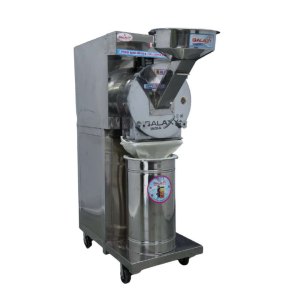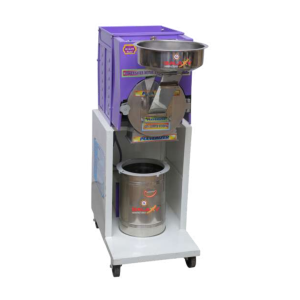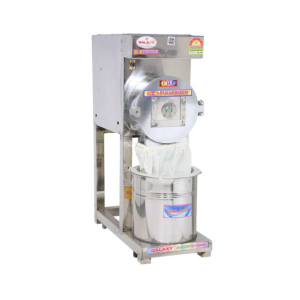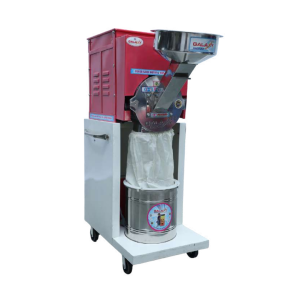Short Description
Centrotech Commercial Aata Maker/Flour Mill/Atta Chakki/Ghar Ghanti Machine
15 to 80 kg per hr Grinding Capacity
Suitable for grindng wheat, Besan, Rice, Sugar, Turmeric, Corn, Ambla, Herbs, Jawar, Millet, Chilly, Spices & Cattle Feed etc
Country of origin: India
Description
The Centrotech Commercial Flour Mill/Atta Chakki as the names suggests, this is a commercial grade machine used for grinding grains into flour. The machine is designed to process high volume of grains and turn them into flour in order to fulfill the commercial requirements. The machine is equipped with a 3 HP motor, has a hopper capacity of 18 kilos and can easily achieve the grinding capacity of 10-60 kilos per hour depending upon the material. The machine requires less operational space, has low power consumption and is made using stainless steel material enhances the overall durability of the machine.
Features:
- Heavy shaft and 100% copper winding motor for continuous grinding
- Big-size feeding hopper
- Fine grinding technology with high durability
- Stainless Steel Build
- Motor protecting overload control switch
Specification:
- Brand: CENTROTECH
- Weight (Approx.) : 90 kg
- Motor Power : 3 HP
- Motor Speed : 2800 RPM
- Voltage : 230V AC
- Phase : Single
- Body Material : Stainless Steel
- Blades : 4
- Jali : 8
- Grinding Chamber : 12 x 6 inch (30.48 x 15.24 cm)
- Hopper Capacity : 18 kg
- Grinding Capacity : 15 to 80 kg per hour
- Dimension (L x W x H) : 66 x 40 x 120 cm
- Weight : 90 kg (Approx.)
Grinding Average Kg/hr :
- Wheat : 16 to 20 kg per hour
- Besan : 26 kg per hour
- Rice : 12 kg per hour
- Sugar : 80 kg per hour
- Turmeric, Corn : 10 kg per hour
- Amla, Herbs : 20 kg per hour
- Jowar, Millet : 10 kg per hour
- Chilly, Spices : 14 kg per hour
- Cattle Feed : 40 kg per hour
Applications:
- Cost Efficiency : By milling flour at home, consumers can significantly reduce the cost of purchasing commercially processed flours, especially for specialty flours that may be overpriced in retail settings.
- Convenient and Time-Saving : The Centrotech flour mill is designed for user-friendliness and efficiency. They enable quick milling, making it convenient for busy households and businesses to incorporate fresh flour into daily meals.
- Fresh Flour Production : The primary application of the flour mill/atta chakki is to produce fresh flour from various grains to ensure availability of fresh flour during all times.
- Nutrient Retention : Milling grains at home preserves essential nutrients that are often lost during commercial milling processes, promoting a healthier diet by utilizing whole grains.
Usage:
Step 1 : Prepare Your Grains
- Measure out the amount of grains you intend to mill.
- Make sure your grains are clean and free from stones or debris, as this can damage the machine.
Step 2 : Assemble the Machine
- For assembling the machine, follow the instructions in the manual carefully.
Step 3 : Adjust the Grind Settings
- The Centrotech flour mill typically features adjustable settings for fine to coarse flour. Depending on your needs, set the grind level using the designated knob or dial.
- Customize the settings for achieving the desired flour fineness.
Step 4 : Mill the Grains
- Pour the grains into the feed hopper. Make sure to not exceed the recommended capacity.
- Turn on the machine using the power switch. The grinding process will begin, and you will notice the sound of the grains being milled.
- Monitor the milling process, ensuring that nothing obstructs the feed area or the discharge.
Step 5 : Collect the Flour
- Once milling is complete, turn off the machine and allow it to come to a stop before opening the grinding chamber.
- Clear any flour residue from the grinding chamber, if needed.
- Collect the freshly milled flour from the discharge area. It’s advisable to store the flour in an airtight container in a cool, dry place for optimal freshness.
Maintenance :
- Regular Cleaning : After each use, clean the machine thoroughly according to the manufacturer’s instructions. This typically involves wiping down the exterior and removing any flour build-up inside the grinding chamber.
- Check for Wear : Regularly inspect the grinding blades for wear and tear. Replace them as necessary to maintain milling efficiency.
- Servicing : Periodically, consider having your flour mill serviced by a professional, especially if you notice any unusual noise or diminished performance.






